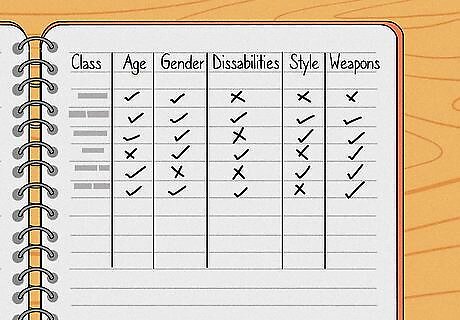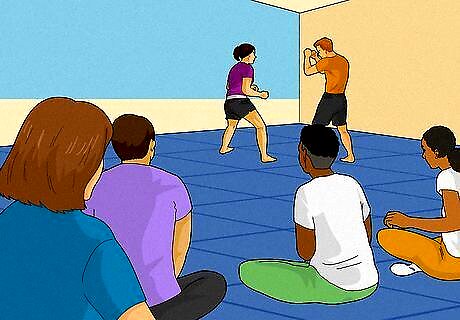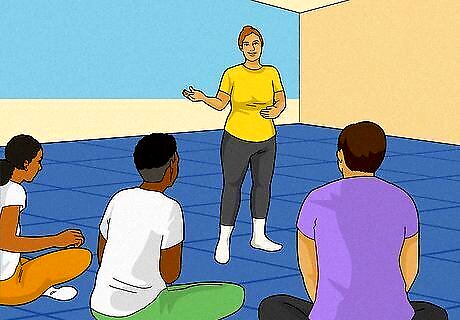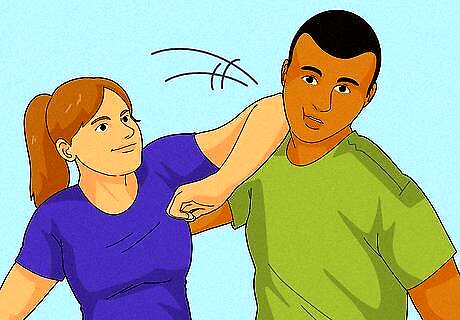
views
Searching for Classes

Make a list of local classes. Search online with keyword searches for programs in your area. Ask friends, family, or other acquaintances who may have taken classes in the past or are currently enrolled. Additionally, contact or visit the websites for the following organizations to find recommendations about respected instructors, especially if programs are required to have licensing or certification in your town: Your local police department Local rape crisis centers Nearby colleges and universities Gyms and fitness centers.

Narrow down by sub-groups. Expect to find a variety of classes with specific focuses. Make a second list based on your needs and preferences. These may include: Age Gender Disabilities Style of defense Weapons

Check how long they last. Expect a full course to last approximately two to three months. However, don’t shy away from shorter programs. Favor classes that aim to teach basic techniques in a short time. Avoid open-ended programs that actively push you to enroll in more advanced training after your beginner’s course. That isn’t to say that you shouldn’t continue training with more advanced courses if you want to. Rather, self-defense classes should aim to teach you basic concepts right up front, unlike martial arts classes, which are typically taught as lifelong journeys.

Avoid martial arts classes. Search instead for programs that are specifically labeled as “self-defense.” Although self-defense classes may incorporate techniques from martial arts, don’t confuse them as being the same thing. Remember that: Martial arts classes might teach tactics that could be used for self-defense, but only as a small part of a broader program. They also won’t teach tactics that aren’t part of their particular martial art. Martial arts are not guaranteed to work in real-world situations.
Picking the Right Class

Visit the program. For each one you’re interested in, find out when the next class is in session. Arrive beforehand. Meet the instructor and ask to observe (or even take part in) the class. Since people who have already experienced assault often seek self-defense classes, a respectful instructor should be patient with prospective new students. If they refuse to let you observe the class, or push you into taking part before you’re ready, consider this a possible red flag. EXPERT TIP Adrian Tandez Adrian Tandez Self Defense Trainer Adrian Tandez is the founder and head instructor of the Tandez Academy, a world-renowned self-defense training center in Mountain View, California. Trained under the renowned martial artist Dan Inosanto, Adrian is a certified instructor in Bruce Lee's Jeet Kune Do, Filipino Martial Arts, and Silat, among other things. Adrian has over 27 years of self defense training experience. Adrian Tandez Adrian Tandez Self Defense Trainer You can cut down on your fear. Adrian Tandez, a self-defense expert, says: “It’s when you don’t have the knowledge and the training that you become afraid. But fear doesn’t have to be a part of your vocabulary. If you learn how to handle situations, you’re not going to be afraid. Caution and awareness are important, and there is always an element of fear, but you can cut it down.”

Pay attention to the moves. As training begins, watch the techniques that the instructor uses. Also pay attention to the students’ ability to perform them. Ask yourself the following: Is the class practical? Do the techniques seem useful in scenarios you might actually encounter in life? Are the students able to execute them effectively? Do the moves seem too complicated for you to execute?

Judge the culture of the class. Observe the class in action. Then speak with other students to find out what they think of it. Make sure that it is the right fit for you, especially if you have experienced real assault in your own life. Don’t waste time in an unsupportive environment that makes you shy away from taking part. Ask questions like: Do other students feel more empowered by this class, or more afraid or certain of being attacked in real life? Are the simulations too reminiscent of actual attacks you may have suffered? Are the students supportive of each other, or too competitive?

Consider the instructor’s gender. Depending on your own, decide whether you are comfortable with theirs. If you are impressed with the class overall, but would rather have another instructor, ask if any others teach the same class. If you are a woman, you may prefer another woman as a positive role model. Or you may prefer a man so you can train against them. If you are a man, you may feel reluctant to fully engage with a woman. You may also consider being attacked by one in real life less likely than being attacked by another man.
Recognizing Red Flags

Beware of promises. Treat any class that sells itself as “guaranteed” as untrustworthy. Although it may seem counterintuitive, favor programs that admit to uncertainty. Look for instructors who advise techniques that are “likely” to work in the “right” circumstances, rather than those who swear that a tactic will “always” work. There is no way to safely replicate a real-world assault in class. This means that techniques learned in simulations may not always work in real life. Instructors should be honest and forthcoming about this important point.

Look for emphasis beyond physical fighting. Expect instructors to also teach self-defense tactics that don’t involve violence or direct confrontation with assailants. If you are observing a class that seems to only touch on these, ask the instructor afterward if that just happens to be today’s lesson, and if other methods are taught. Other areas should include: Awareness of your environment to avoid confrontations. Verbal techniques to de-escalate situations.

Prioritize simplicity. Remember: you aren’t an athlete training to be a blackbelt, but to defend yourself in real-world scenarios regardless of your physical fitness. Expect the instructor to respect this. Whatever technique is being taught, they should focus on what you are capable of doing right now, rather than force you to achieve a goal beyond your reach. Favor classes that teach simple moves that you can perform easily. If the techniques being taught are too complex or require physical abilities that you do not possess, choose a new class if the instructor continues to insist on them. EXPERT TIP Adrian Tandez Adrian Tandez Self Defense Trainer Adrian Tandez is the founder and head instructor of the Tandez Academy, a world-renowned self-defense training center in Mountain View, California. Trained under the renowned martial artist Dan Inosanto, Adrian is a certified instructor in Bruce Lee's Jeet Kune Do, Filipino Martial Arts, and Silat, among other things. Adrian has over 27 years of self defense training experience. Adrian Tandez Adrian Tandez Self Defense Trainer Don’t live your life paranoid. Adrian Tandez, a self-defense expert, says: “You shouldn’t live your life paranoid that something is going to happen. One benefit of learning how to protect yourself with self-defense training is that you know if something happens, you can handle it. You don’t have to be overly nervous or anxious anymore.”



















Comments
0 comment